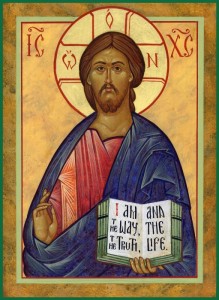I don’t know if I’ve ever eaten a candy cane. I tried one once, and it was way too sweet. We have about a dozen of them in the house. We use them for tree ornaments. They are like family heirlooms; I’m pretty sure I got them from my mom. She probably got them from her mom, and so on. It’s kind of random that a peppermint treat would end up becoming a symbol of Christmas. Yes, I’ve heard the symbolism: the crook is the crook of a shepherd (Christ is the great shepherd), the white is for Christ’s purity, and the red is for his blood.
Another way to look at the symbolism is that the white is for Christ’s divinity (He is fully God) and the red is for His humanity (He is fully man). This bit of imagery is not perfect: in most icons of Christ, red is the color of His godly majesty and blue is the color of His humanity (which is why he wears a blue cloak over a red shirt; the opposite of His mother, who was “overshadowed” by the Power of the Most High). But then again, colors can have more than one symbolic meaning. We can handle this because it’s true of everything: meaning is always derived from context. I remember when I was in high school, our English teacher passed out a sheet that was meant to be a key for understanding poetry. It had a list of words on the left and what they stood for on the right. I thought it was a bit silly because it was sterile. It had no context. A dove can be a sign of deliverance, of sacrifice, of love, of dinner (especially when wrapped in bacon), or a zillion other things. You figure out a symbols meaning based on the story being told, not the other way around.
I guess the candy cane is pretty Orthodox as the red and white remain distinct. The Ecumenical Council at Chalcedon warned against mixing those colors together; the infinity of the white would completely overwhelm the finite amount of red.
Thanks to Tradition, we know some of the incorrect ways to think about the God-man Christ, but it’s hard to go beyond the basics with words
An icon that switches the colors – it’s only heretical if we go from expected symbolism -> truth rather than the other way around.
(read Lossky to see the strengths and weaknesses of this approach). That’s because you need the context; you need the story. Once you have that, you can figure out the symbols. In this metaphor that I am giving you now, the colors of the candy cane are like the words we use for the Truth of the Incarnation. You can’t understand what the words really mean until you’ve worked your way into the heart of the Gospel. If you start with the words, you are kind of going about it backwards. Words are symbols the same as colors are in icons (e.g. we could have Christ wearing a night blue sky shirt for the infinite majesty of His godliness and a red cloak for the blood of the humanity He put on). When it comes to theology, it best to learn from the ground up. The Councils can give us the same kind of sheet that my teacher gave our class, but it won’t mean much until we’ve got something real to hang those words and symbols on. We need to live the life in Christ, not study it.
All this is to say that Orthopraxis is the best teacher. If we live the live of prayer, sacrifice, charity, and silence, then our understanding of the Mystery will deepen.
Reading books (and even blogs) is no short cut for obtaining real knowledge.


